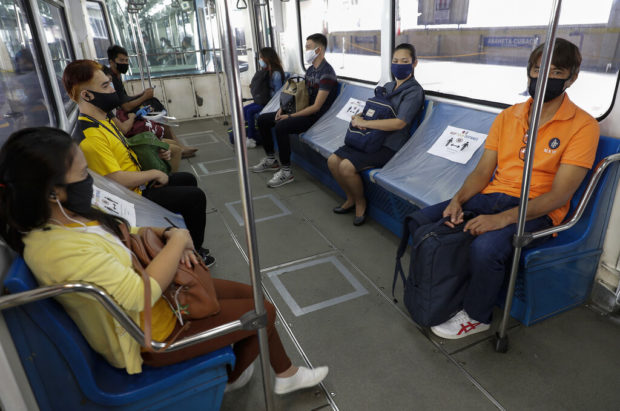
This file photo shows people riding a train with seats arranged for social distancing measures during the first day of a more relaxed coronavirus lockdown in Manila, Philippines on Monday, June 1, 2020. (AP Photo/Aaron Favila)
MANILA, Philippines — With the World Health Organization (WHO) warning in May that the new coronavirus may never be wiped out entirely, a former health secretary has pointed out that Filipinos should learn how to “dance” with COVID-19, perhaps even in the public transport system.
This, while a group of health experts led by former Health Secretary Dr. Manuel Dayrit believes that physical distancing in public transport can in fact be reduced to 0.5 meter or lower, as it recommended the “seven commandments” for mass transportation.
READ: Coronavirus may never go away – WHO
In an interview with INQUIRER.net, Dayrit described as a “whole package of interventions” the seven commandments, as follows:
- Wearing of proper face masks
- Wearing of face shields
- No talking and no eating
- Adequate ventilation
- Frequent and proper disinfection
- No symptomatic passengers
- Appropriate physical distancing
“I guess one thing that should be said here is that even if you are to maintain one-meter distancing, it would be a good idea to apply all of these other interventions. But given that we are trying to open up the economy and public transport, this is a proposal that looks at all of these interventions together and enforcing them and monitoring them,” he said.
Dayrit, who led the government’s fight during the 2003 SARS crisis, said that his group has already submitted this recommendation to the Inter-Agency Task Force on Emerging Infectious Diseases.
His group includes other experts like former Health Secretary Dr. Esperanza Cabral, University of the Philippines-Manila College of Public Health Dean Dr. Vicente Belizario Jr., National Task Force against COVID-19 special advisor Dr. Teodoro Herbosa, Philippine College of Surgeons Cancer Commission Director Dr. Manuel Francisco Roxas, Eye Bank Foundation of the Philippines Founder and CEO Dr. Ma. Dominga Padilla, and infectious disease specialist Dr. Rontgene Solante.
In a joint statement dated September 15, they cited a recent study from the Duke University in North Carolina which showed that surgical masks reduce droplet transmission by up to 99 percent, and that the simple act of not talking can reduce droplet counts by up to four times.
They also said that a meta-analysis published on June 22 in The Lancet, a leading international medical journal, showed that face masks and face shields can independently reduce the chance of viral transmission by up to five-fold and three-fold, respectively.
In China, Japan, Korea, Singapore, Taiwan, Vietnam, and other countries, passengers wear face masks while sitting side-by-side in trains, while COVID-19 cases remain manageable, they also said.
While WHO recommends keeping a distance of one meter from other passengers to the extent possible, this measure “allows for adjustments based on context,” they added.
For Dayrit, many countries know that maintaining the one-meter distance between commuters is “very, very difficult to enforce.”
He also noted that some studies have shown that the transmission of the virus in public transport is not as high as in social gatherings.
“The reason for that is that if you are commuting, and pretty much keeping to yourself and not talking, and you are seated there, there is less social interaction that you might say promotes spreading or transmission,” he added.
In reality, it’s in social gatherings that people lower their guard against COVID-19, particularly when they take off their masks, for example, when eating or conversing, according to Dayrit.
He cited, for instance, an observation in Metro Manila where the transmission of the virus in workplaces most likely happens in canteens or cafeteria.
In some hospitals, it was also observed that health workers most likely get infected when they gather at their quarters and “started relaxing,” even as they protect themselves with personal protective equipment when seeing patients.
“So, given that we want to open up the public transport so that the economy can open, I think we are making the case that if we do all of these things, you will still be protective of people provided they follow the seven commandments,” said Dayrit.
He believes that the government’s decision on maintaining the one-meter rule will be revisited as it grapples with keeping the country safe and opening up the economy, and as more data on coronavirus transmission in public transport comes in.
In one way, the government can choose to lean towards enforcing total lockdowns to hasten the defeat of the virus, and in the other way, it can opt to indiscriminately open up the economy, according to Dayrit.
Both, however, will have consequences, he said, adding that there has to be a balance between these two scenarios.
“I think the message to us is that we have to live with the virus, we have to dance with it, and use what we can to be able to do what we have to do, to open up the economy, to give people jobs while at the same time keeping safety measures enforced and not letting our guard down and not to take unnecessary risks,” the former Health chief concluded.
The Department of Transportation previously proposed the reduction of physical distancing in public transport from one meter to 0.75, then eventually to 0.5 and 0.3 meter. This drew objection from the Department of Health that its implementation was later suspended by Malacañang.
READ: It’s final: 1-meter social distancing in public transportation stays
KGA
RELATED STORIES
DILG chief favors more PUVs over eased physical distancing rules
Physicians’ group warn distancing cut may lead to spike in infections
Ventilation, short trips can reduce COVID-19 risk in public transport

